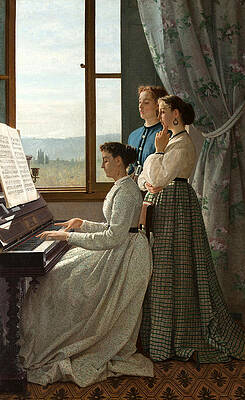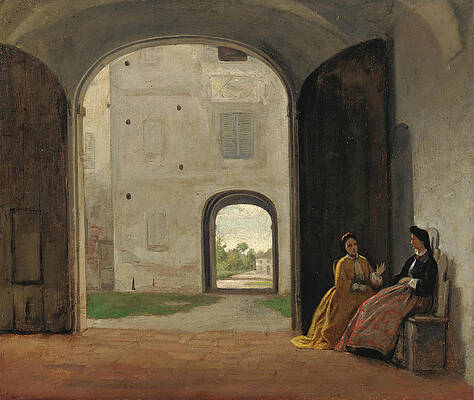Silvestro Lega
Paintings
Singing a ditty
Battitori di fieno
The Conversation
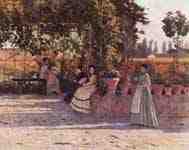
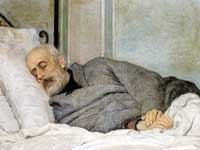
The Dying Mazzini (Mazzini morente)
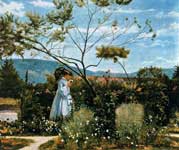
Among the flowers in the garden
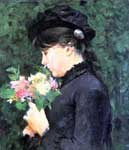
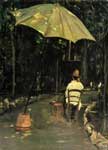
The painter Tommasi who paints in the garden

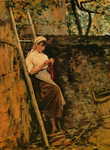
Country Girl Leaning against a Ladder

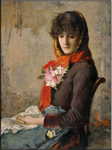
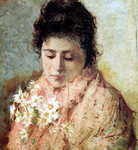
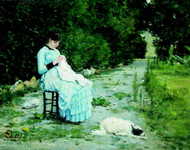
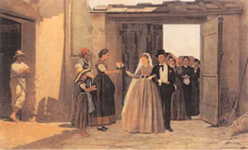
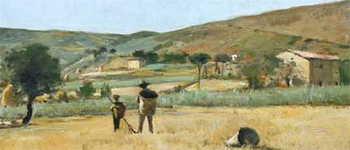
Gabbro landscape with peasants


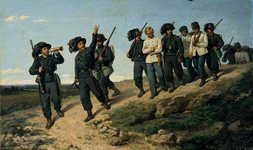
Return of sharpshooters from a reconnaissance
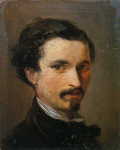
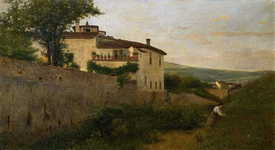
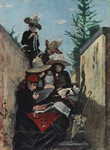
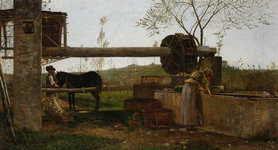
Fine Art Prints | Greeting Cards | iPhone Cases | Tote Bags | Clothing | Lifestyle | Beach ...
Silvestro Lega (8 December 1826 – 21 September 1895) was an Italian realist painter. He was one of the leading artists of the Macchiaioli and was also involved with the Mazzini movement.
Biography
Silvestro Lega Painting (1866–67) by Giovanni Fattori
Lega was born in Modigliana, near Forlì, to an affluent family. From 1838 he attended the Piarist College, where his skill at drawing became evident. From 1843 to 1847 he attended the Accademia di Belle Arti, Florence, studying drawing under Benedetto Servolini (1805–79) and Tommaso Gazzarini (1790–1853), then studying painting, briefly, under Giuseppe Bezzuoli. During 1847 he attended Luigi Mussini’s school, where the teaching emphasized the 15th-century Florentine principles of drawing and orderly construction. Then and for some years afterwards he continued to attend the Scuola del Nudo of the Accademia.
As a Garibaldian volunteer, Lega participated in the military campaigns for Italian independence (1848–49) before resuming his training, this time under Antonio Ciseri.[1] In 1850 he completed his first large-scale painting, Doubting Thomas (Modigliana, Osp. Civ.). In 1852 he won the Concorso Trienniale dell’Accademia with David Placating Saul.[1] On 30 January 1853, he became a member of the Accademia degli Incemminati of Modigliana. In 1855, Lega returned to his native town, where he remained until 1857.
Serious by nature, Lega was an infrequent visitor of the Caffè Michelangiolo, a favorite meeting place in the 1850s for the young painters who later became known as the Macchiaioli. Diego Martelli, a contemporary of Lega, wrote of him that "he was not one of those people who, artistically speaking, can fling themselves into novel developments .... In spite of the discussions that went on nightly in the crucible of the Caffè Michelangiolo, Lega's art, until 1859, remained conspicuously academic."[2] Subsequently, Lega's style began moving towards Realism and away from the Purismo of Mussini.[3] This progress is evident in the four lunettes he painted between 1858 and 1863 for the Oratory of the Madonna del Cantone in Modigliana, and in several military-themed works he painted during that period.[4] Together with his Macchiaioli friends Odoardo Borrani, Giuseppe Abbati, Telemaco Signorini and Raffaello Sernesi, he started painting landscapes en plein air.
From 1861 to 1870, he lived with the Batelli family, near the Affrico river, and started a relationship with the elder daughter, Virginia. The children and women of the Batelli family were the subjects of many of his paintings during this happy period of his life.[3]
In 1870, he was awarded the silver medal at the Parma's National Exposition. In that same year, Virginia Batelli, his companion, died of tuberculosis. Three of Lega's brothers also died at about this time.[3] The grieving Lega returned to Modigliana. Depressed, and experiencing the onset of eye problems, he ceased painting almost entirely for four years between 1874 and 1878.[3] In 1875 he and Borrani established a modern art gallery in Florence, but it quickly failed, and Lega's financial problems worsened.[5] In 1878 he took part in the preparation of the Parigi's Universal Exposition. At the Florentine Promotrice in 1879, Lega—who never traveled outside Italy—saw two Impressionist paintings by Camille Pissarro, which he admired.[6]
He became a frequent guest of the Tommasi family, and a tutor of the sons of the family. The art historian Norma Broude says that "like the Batellis before them, [the Tommasis] welcomed Lega into their family circle and provided for him the warm and close-knit family environment in which he and his art could flourish."[5] In 1886 he painted one of his most famous works, the Gabbarigiane.
By the mid-1880s, Lega was almost blind, and perceived only large masses. He produced many paintings in Gabbro, where he was a guest of the Bandini family.[3] He participated at the Exposition Universelle (1889) and at the Promotrice of Florence.
Lega died in Florence in 1895 of stomach cancer.
Style
Lega's artistic career may be divided into two periods: the first is the calm phase, where he looked at the world optimistically. The second is the disturbed phase, associated with his poor economic conditions and with his depression after Virginia's death.
Efrem Gisella Calingaert says:
the originality of Lega’s style lies in the way he adapted a contemporary use of colour, based on direct experience of the motif, to a traditional type of composition and carefully defined forms. This is illustrated by the Singing of the Ballad (1867; Florence, Pitti), which, together with A Visit (1868; Rome, G.N.A. Mod.) and The Pergola, constitute the most important works of Lega’s mature period and perhaps of his whole career. In the Singing of the Ballad the simplicity and balance of the composition, the transparency of the colours and rendering of atmosphere, the monumentality of the figures in profile and their pyramidal forms invest the scene with the solemnity of a painting by Piero della Francesca.[3]
Partial list of works
Giuseppe Mazzini Dying (1873)
Il sacro cuore di Gesù, oil painting
La casa di don Giovanni Verità, 1855, oil on canvas, 37 x 28, Livorno, museum Civico
Episodio della guerra del 1859 - Ritorno di bersaglieri italiani da una ricognizione, 1861, oil on canvas, 57,5 x 95, Florence, National Gallery of Modern Art, Palazzo Pitti
Ritratto di Giuseppe Garibaldi, 1861, oil on canvas, 111 x 78,4, Private collection
Tra i fiori del giardino, 1862, oil on canvas, 49 x 59, Private collection
Il primo dolore, 1863, oil on canvas, 39,5 x 50, Genoa, Provincial Palace
L’educazione al lavoro, 1863, oil painting, 87 x 65, Hotel Montecatini Terme, Tuscany, Private collection
L’elemosina, 1864, oil on canvas, 71,8 x 124, Private collection
La nonna, 1865, oil on canvas, 59 x 70, Private collection
Due bambine che fanno le signore - Divertimento infantile, 1865, oil on canvas, 57,5 x 94, Private collection
Il canto di uno stornello, 1867, oil on canvas, 158 x 98, Florence, National Gallery of Modern Art, Palazzo Pitti
Un dopo pranzo, 1868, oil on canvas, 75 x 93,5, Milan, Pinacoteca di Brera
La visita, 1868, oil on canvas on wood panel, 31 x 60, Rome, National Art-Modern Galery
I promessi sposi, 1869, oil on canvas, 33,5 x 77, Milan, Museum of Science of Leonardo da Vinci
La lettura, oil on paper laid down on wood, Bari, Provincial art-Gallery
Donna con edera, oil on board, Genoa Nervi, Raccolte Frugone Gallery
Una madre, 1884, oil on canvas, 191 x 124, Private collection
Gabbrigiana in piedi, 1888, oil on canvas, 140 x 86, Private collection
Pagliai al sole, oil on board, 28 x 38, ca 1890, Piacenza, Gallery Ricci Oddi
Notes
Steingräber & Matteucci 1984, p. 113.
Broude 1987, p. 151.
Calingaert, "Lega, Silvestro", Grove Art Online
Broude 1987, pp. 153–154.
Broude 1987, p. 171.
Broude 1987, pp.172–174.
References
Broude, Norma (1987). The Macchiaioli: Italian Painters of the Nineteenth Century. New Haven and London: Yale University Press. ISBN 0-300-03547-0
Calingaert, Efrem Gisella. "Lega, Silvestro." Grove Art Online. Oxford Art Online. Oxford University Press.
Steingräber, E., & Matteucci, G. (1984). The Macchiaioli: Tuscan Painters of the Sunlight : March 14-April 20, 1984. New York: Stair Sainty Matthiesen in association with Matthiesen, London. OCLC 70337478
----
Fine Art Prints | Greeting Cards | Phone Cases | Lifestyle | Face Masks | Men's , Women' Apparel | Home Decor | jigsaw puzzles | Notebooks | Tapestries | ...
----
Artist
A - B - C - D - E - F - G - H - I - J - K - L - M -
N - O - P - Q - R - S - T - U - V - W - X - Y - Z
Retrieved from "http://en.wikipedia.org/"
All text is available under the terms of the GNU Free Documentation License


